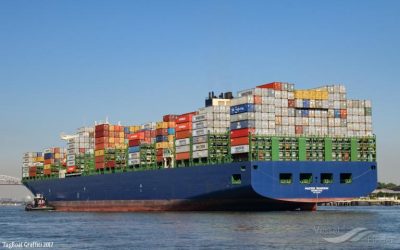This weekend, 74 steel containers fell from the Maersk Shanghai near Oregon Inlet as the result of high winds from a nor’easter. Photo: contributed
OFF OREGON INLET — Of the 74 huge steel containers that fell from a cargo ship near Oregon Inlet during the weekend nor’easter, as of Wednesday afternoon, all are still floating in the ocean somewhere off the coast.
One holds 5,913 pounds of sulfuric acid in big plastic boxes, a hazardous substance that is not considered a significant threat when diluted with saltwater.
So far, nine of the containers tossed off the Maersk Shanghai about 17 miles off Oregon Inlet have been spotted, said Petty Officer Corinne Zilnicki at the Coast Guard Portsmouth, Virginia, office. It is not known whether any of them is the one containing the acid, she said, because the markings are difficult to detect.
The Coast Guard issued a notice to mariners after they were notified at 10:10 p.m March 3, according to Petty Officer Ronald Hodges, Public Affairs Detachment Baltimore. Most of the containers have been spotted during Coast Guard C-130 flights from Oregon Inlet to Cape Lookout, he said.
The first one was seen about 14 miles off Hatteras Inlet at 6:53 p.m. March 4, followed by sightings of three more in quick succession. On March 5, a fifth container was spotted at 12:32 p.m. by the cruise ship Norwegian Breakaway, with two more spotted that day before 2 p.m. Finally, a ninth container was sighted on March 6 at 1:20 p.m., about 27 miles northeast of Oregon Inlet.
Hodges said that the Maersk Shanghai had been heading to Charleston, South Carolina, from Norfolk, Virginia, with its origin from Liberia. It held about 3,000 containers.
These cargo vessels operate in constant rotation. Photo: Contributed
The container with the sulfuric acid – we confirmed it’s not on the boat,” Hodges said. ‘We assume it’s in the water.” But the vessel had to be diverted to Freeport, Bahamas, due to limited berthing options in Charleston, Katherine Mosquera, North America regional communications manager for Denmark-based Maersk, said Wednesday in an email.
The cargo ship is expected to reach Freeport on March 8, she said. Cargo customers are being updated daily on their shipments, she added.
Vessels like the Shanghai, which is a chartered vessel, operate under a constant rotation, Mosquera said.
“There is no starting or ending,” she wrote, “for the journey is a just a constant loop under the lane they operate on.”
Mosquera said that the company “at this time” is not aware of any other hazardous cargo that may have been lost overboard. She did not elaborate on what the other shipments contained.
Tracking and recovery efforts for the lost containers is underway, she said.
Standard steel containers, she said, can range in size from 20 feet by 8 feet by 8.6 feet to as large as 54 feet by 8 feet by 9.6 feet.
“No containers have yet been recovered owing to local weather conditions, but operations are ongoing,” Mosquera said in the email. “The vessel owners, Stovep Marine, will take the lead in all salvage and recovery of containers lost overboard.”
Frank Csulak, a National Oceanic and Atmospheric Administration, or NOAA, scientific support coordinator in Point Pleasant, New Jersey, said in an interview on Wednesday that he was told by the Coast Guard that the 40-foot containers blew off the ship in 40 to 50 mph winds off the Outer Banks. The container with the sulfuric acid held the liquid in large polyethylene plastic boxes within the steel container.
Sulfuric acid is generally used to make fertilizer and in water treatment systems, he said. Although it can be very toxic if it is breathed or touches skin, the chemical is neutralized in saltwater.
Even if the container sank – a common occurrence when containers are filled – it is not likely to leak from the plastic box.
“If the container – the polyethylene container – did break open,” he added, “the sea water would neutralize it quickly.” He also said he would not expect there to be any impacts on marine life.
“It’s not good, but fortunately, it was only one container,” Csulak said.
But Csulak said that it appears that a number of the containers still onboard the cargo ship were damaged during the storm, which may explain why the vessel had to be diverted.
“They’ve got to go through every container one-by-one,” he said.
The Coast Guard is continuing to warn mariners to be on the lookout for the containers.
“Our biggest concern is the threat these pose to navigation,” Hodges said.
Like This Story?
It costs about $500 to produce this and all other stories on CRO. You can help pay some of the cost by sponsoring a day on CRO for as little as $100 or by donating any amount you're comfortable with. All sponsorships and donations are tax-deductible.



How meny containers are lost at sea?
ReplyDelete